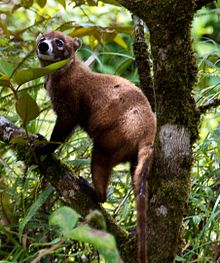- White-nosed coati
-
White-nosed coati[1] 
In Costa Rica Conservation status Scientific classification Kingdom: Animalia Phylum: Chordata Class: Mammalia Order: Carnivora Family: Procyonidae Genus: Nasua Species: N. narica Binomial name Nasua narica
(Linnaeus, 1766)Subspecies - N. n. molaris Merriam, 1902
- N. n. narica Linnaeus, 1766
- N. n. nelsoni Merriam, 1901
- N. n. yucatanica J. A. Allen, 1904[1]

White-nosed Coati range The white-nosed coati (Nasua narica) is a species of coati and a member of the family Procyonidae (raccoons). Local names include Pizote, Antoon and Tejón. The last, which mainly is used in Mexico, means badger. It averages about 4–6 kg (8.8-13.2 lbs) in weight.[3] However, males are much larger than females, and small females weigh as little as 2.5 kg (5.5 lbs) and large males as much as 12.2 kg (27 lbs).[4][5] On average, the total length is about 110 cm (43 in), about half of that being the tail length.
Contents
Habitat and range
 Coati in Rincón de la Vieja Volcano National Park, Costa Rica
Coati in Rincón de la Vieja Volcano National Park, Costa Rica
White-nosed coatis inhabit wooded areas (dry and moist forests) of the Americas. They are found at any altitude from sea level to 3,500 m (11,500 ft), and from as far north as southeastern Arizona and New Mexico to as far south as Ecuador.
White-nosed coatis have also been found in the U.S. state of Florida, where they are an introduced species. It is unknown precisely when introduction occurred; an early specimen in the Florida Museum of Natural History, labeled an "escaped captive", dates to 1928. There are several later documented cases of coatis escaping captivity, and since the 1970s there have been a number of sightings, and several live and dead specimens of various ages have been found. These reports have occurred over a wide area of southern Florida, and there is probable evidence of breeding, indicating that the population is well established.[6]
Feeding habits
They are omnivores, preferring small vertebrates, fruits, carrion, insects, and eggs. They can climb trees easily, where the tail is used for balance, but they are most often on the ground foraging. Their predators include boas, raptors, hunting cats, and Tayras (Eira barbara). They readily adapt to human presence; like raccoons, they will raid campsites and trash receptacles. They can be domesticated easily, and have been verified experimentally to be quite intelligent.
Behavior
They are primarily diurnal, retiring during the night to a specific tree and descending at dawn to begin their daily search for food. However, their habits are adjustable, and in areas where they are hunted by humans for food, or where they raid human settlements for their own food, they become more nocturnal. Adult males are solitary, but females and sexually immature males form social groups. They use many vocal signals to communicate with one another, and also spend time grooming themselves and each other with their teeth and claws. During foraging times, the young cubs are left with a pair of babysitters, similar to Meerkats. The young males and even some females tend to play-fight. Many of the coatis will have short fights over food.
References
- ^ a b Wilson, Don E.; Reeder, DeeAnn M., eds (2005). Mammal Species of the World (3rd ed.). Baltimore: Johns Hopkins University Press, 2 vols. (2142 pp.). ISBN 978-0-8018-8221-0. OCLC 62265494. http://www.bucknell.edu/msw3/browse.asp?id=14001625.
- ^ Samudio, R., Kays, R., Cuarón, A.D., Pino, J.L. & Helgen, K. (2008). Nasua narica. In: IUCN 2008. IUCN Red List of Threatened Species. Downloaded on 26 January 2009.
- ^ David J. Schmidly; William B. Davis (1 August 2004). The mammals of Texas. University of Texas Press. pp. 167–. ISBN 978-0-292-70241-7. http://books.google.com/books?id=QdlJ3SbwUIgC&pg=PA167. Retrieved 15 September 2011.
- ^ North American Mammals: Nasua narica. Mnh.si.edu. Retrieved on 2011-09-15.
- ^ Coati (Nasua narica). Wc.pima.edu. Retrieved on 2011-09-15.
- ^ Simberloff, Daniel; Don C. Schmitz, and Tom C. Brown (1997). Strangers in Paradise: Impact and Management of Nonindigenous Species in Florida. Island Press. p. 170. ISBN 1559634308. http://books.google.com/?id=rtrpSllq4SQC&printsec=frontcover#v=onepage&q&f=false. Retrieved March 29, 2011.
External links
Categories:- IUCN Red List least concern species
- Procyonidae
- Animals described in 1766
- Mammals of Central America
- Mammals of Colombia
- Mammals of Mexico
- Fauna of the Southwestern United States
- Mammals of the United States
- Mammals of Costa Rica
- Mammals of Guatemala
Wikimedia Foundation. 2010.


